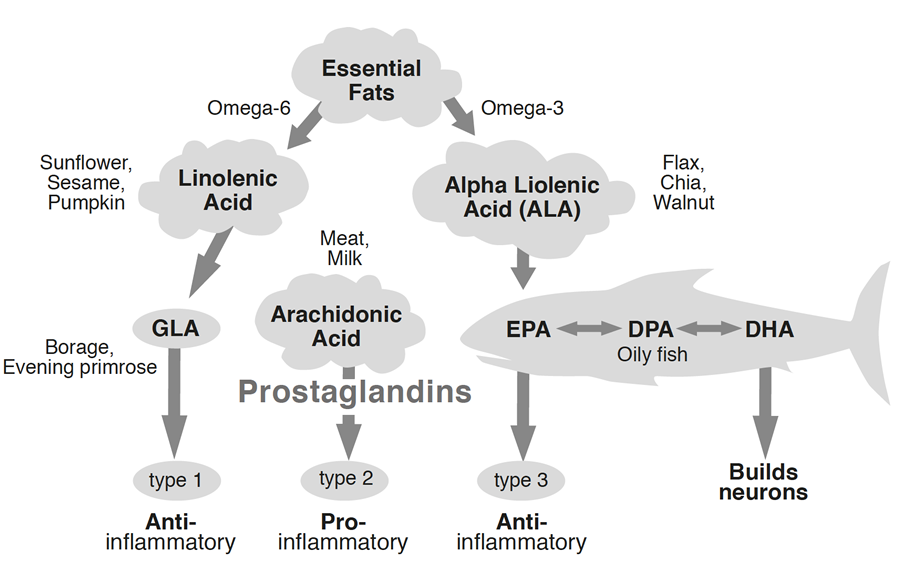By now you’re well aware that getting enough omega-3 DHA into your brain is a vital part of brain health. As much as we love and encourage you to eat foods such as chia, walnut, flax, and cold climate greens, high in omega-3 ALA, the conversion to even EPA averages around 5% and even less to DHA.
Can this be improved? The answer is ‘yes’, by three means.
The first is to improve the ratio of omega-6 fats in your diet, which compete with omega-3 fats. In the diagram below you’ll see that omega-6 fats, which mainly come from a hotter climate which, from sources such as sunflower and sesame, should convert into their most powerful form, GLA, which is what you get in evening primrose oil or borage oil, often used in supplements. GLA is an anti-inflammatory and helps, for example, balance hormones. The final conversion is also blocked by ‘insulin resistance’, a consequence of too much junk food high in sugar and carbs. You’ll be dealing with this in the LOW GL domain.

© Patrick Holford & Piatkus
The enzymes that do all this conversion from ALA to DHA and linolenic acid (LA) to GLA depend on certain nutrients such as B vitamins, zinc, and magnesium. Having enough of these is a good start, but the real problem is that our modern day diet, on average, has something like six times more omega-6 than omega-3, while our ‘semi-aquatic’ ancestors and hunter gatherers that lived along the water’s edge, had more like 1:1 ratio of omega-3 to 6, and lots more from eating marine food.
That’s because we fry in sunflower oil, use omega-6 oils from sunflower, safflower, peanut and soya in processed foods and the meat we eat has usually been fed a grain-based diet, perhaps corn, again high in omega-6.
A lot of processed foods avoid these essential fats completely because they’ll reduce the shelf-life of a food as they become rancid. Good food goes off. Most people are lacking both undamaged, good quality omega-6 and omega-3 but are relatively more deficient in omega-3.
So, one way to get more DHA into your brain is to stop eating these kinds of foods. In the next email we’ll show you how to cook without sunflower/safflower oil – in salad dressings, for example.
Your homework for today and tomorrow is to become aware of all the food sources that contain omega-6, from the oils you fry in, to processed foods containing sunflower, safflower, peanut or soya or their oils. That’s not to say you should never eat these foods.
Meanwhile, load up on chia, flax, walnut, pecans, macadamia and seafood to swing the omega-3/6 ration in your favour.
To give you an idea here’s the ratio of omega-3 to 6 fats in common foods.
| omega-3 | omega-6 | |
| cold-water fish | 100% | 0% |
| chia | 70% | 22% |
| flaxseed | 57% | 14% |
| walnut | 52% | 10% |
| canola (rape seed) | 9% | 20% |
| peanut | 0% | 32% |
| sesame | 0% | 42% |
| soya | 7% | 51% |
| corn | 0% | 54% |
| sunflower | 0% | 65% |
| safflower | 0% | 75% |
| olive oil | 0% | 6% |